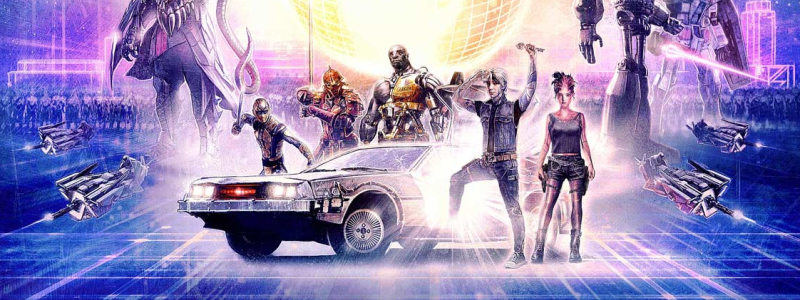In recent years, Steven Spielberg has had his gaze focused firmly on the past.
From Abraham Lincoln and the fight for emancipation to The Washington Post battling for freedom of the press, Spielberg is working him way, statesmanlike, through American history, celebrating the better angels of our nature; like Frank Capra with a library card. It’s a decent enough third act for any filmmaker – he’s even found himself his very own Jimmy Stewart in the form of Hollywood superstar/lovable everyman Tom Hanks – if a little predictable for the filmmaker who one directed Jurassic Park and Schindler’s List in the same year.
If The Post was this year’s Schindler’s List, then Ready Player One is this year’s Jurassic Park – as well as being indebted to every major blockbuster before and since then. The book by Ernest Cline is essentially Fifty Shades for geeks; an unabashed nostalgia trip masquerading as sci-fi fantasy, based on the none-more-fannish premise that one man’s knowledge of pop culture can save the world.
Wade Watts (Tye Sheridan) is a teenager living in The Stacks, an elevated trailer park on the outskirts of Columbus, Ohio, with his frazzled aunt (Susan Lynch) and her deadbeat, heart-tattooed BF (Ralph Ineson). The year is 2045 and the world is a mess: an energy crisis, mass debt and unemployment, corporate servitude. For billions of struggling people, their only escape is the OASIS, a fully immersive virtual reality universe where you can be or do anything you want.
That’s provided its generic – Wade’s avatar Parzival is a silver-haired sprite – or ideally property of Warner Bros. You can hang out in Minecraft World, or go mountain climbing with Batman, but anything from Star Wars might be a hyper-jump too far. Or you can dedicate yourself to Anorak’s Quest, a scavenger hunt for a mysterious Easter egg left behind by the MMORPG’s brilliant, reclusive creator James Halliday (Mark Rylance, reliably twinkly as BFJobs) – now dead. The prize: nothing less than a vast fortune and ownership of the OASIS itself, and presumably a whole lot of geek cred.
In a neat spot of meta-casting, villain-of-the-moment Ben Mendelsohn plays slimy businessman Nolan Sorrento, CEO of the evil corporation IOI, who looks like an ’80s-movie high-school principal and who views the OASIS as an economic resource to be exploited. As such, it falls to the plucky youngsters – Parzival, bad-ass love interest Art3mis (Olivia Cooke), best mate Aech (Lena Waithe) – to beat them to the treasure for the sake of all the citizens of the OASIS.
Ready Player One is, at its heart, a classic adventure movie of the type Spielberg once specialised in, but which he hasn’t made since 2011’s The Adventures Of Tintin. He’s certainly the only director who could have brought together all the elements necessary to translate Cline’s novel to the screen; not least in the endless homages to his contemporaries. References to his own filmography are relatively thin on the ground, though we do get to see a T-Rex chase the DeLorean from Back To The Future through the streets of Little China.
The film’s screenplay, adapted by Zak Penn and Cline himself, necessarily streamlines and intensifies the hero’s journey; tying the quest directly to Halliday’s personal history rather than just his love of trivia. The young cast are immensely likeable, but a newly inserted moral about not letting life pass you by doesn’t ring true coming from the mouth of an attractive teenager. The famous “Spielberg shot” is that of a face open-mouthed and wide-eyed, illuminated by wonder. Ready Player One certainly has that, but here it’s the wonder of rediscovery – of seeing all your favourite toys laid out together in a huge CGI play-box.
The references, too, are more mainstream – no more Rush or Dungeons & Dragons. If this is Fifty Shades for geeks, it’s very, well, vanilla.With the riddles that lead to the keys made correspondingly less obscure, it also somewhat defies plausibility that the combined brainpower of so much of the world’s population, already desperate and further incentivized by the prospect of half a trillion dollars, wouldn’t have it solved in five minutes flat; especially given the film also loses much of the scope and complexity of the OASIS that makes discovery so more plausible.
Instead, the film has to rely on nostalgia and scale. An entirely CGI climactic battle between armies of intellectual properties battling for the fate of the world plays like a hyperkinetic Where’s Wally; including the Iron Giant, multiple Master Chiefs, and a scattering of movie monsters; notably not all of them New Line (“It’s fucking Chucky!”). It’s “visually ambitious”, sure, but all of this just made me nostalgic for The Adventures of Tintin, Spielberg’s last blockbuster, which came out in 2001.
The film’s maddest sequence immerses you in a full-blown recreation of the Overlook Hotel, rushing you through a greatest hits of The Shining turned up to 11. Those two creepy little girls have become such an obvious cultural reference, they even pop up in The Angry Birds Movie. In lesser hands, Ready Player One might have simply felt much the same: like a cynical corporate branding exercise designed, instead of selling apps to kids, to sell your childhood back to you.
Alan Silvestri’s score riffs on everything from Back To The Future to Willy Wonka & The Chocolate Factory and Joseph Kominski’s cinematography is gritty and glossy, sharp and sleek; all the best to keep your eye out for your favourite bit of IP. Still, despite the song to the contrary, this is impure imagination; a slightly alienating blend of the generic and the specific, the epic and the exacting, the cynical and the earnest, that left me feeling slightly dirty; if occasionally exhilarated.
